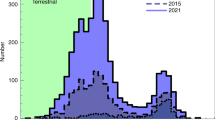Abstract
We review current knowledge of the giant, long-lived eddies observed in the atmospheres of the Major Planets. Particular emphasis is placed on determining the dynamical processes which may be at work, and we discuss a range of both theoretical and laboratory models which have been suggested as analogues of these features.
Access this chapter
Tax calculation will be finalised at checkout
Purchases are for personal use only
Preview
Unable to display preview. Download preview PDF.
Similar content being viewed by others
References
Stephenson, D. J.: Interiors of the giant planets, Ann. Rev. Earth Plan. Sci, 10 (1982), 257–295.
Gierasch, P. J. & Conrath, B. J.: Vertical temperature gradients on Uranus: implications for layered convection, J. Geophys. Res., 92 (1987), 15019–15029.
Conrath, B. J. & Gierasch, P.: Global variation of the para hydrogen fraction in Jupiter’s atmosphere and implications for dynamics on the outer planets, Icarus, 57 (1984), 184–204.
Read, P. L.: Stable, baroclinic eddies on Jupiter and Saturn: a laboratory analog and some observational tests, Icarus, 65 (1986), 304–334.*
Achterberg, R. K. & Ingersoll, A. P.: A normal-mode approach to Jovian atmospheric dynamics, J. Atmos. Sci., 46 (1989), 2448–2462.
Ingersoll, A. P.: Atmospheric dynamics of the Outer Planets, Science, 248 (1990), 308–315.*
Polvani, L. M., Wisdom, J., DeJong, E. & Ingersoll, A. P.: Simple models of Neptune’s Great Dark Spot, Science, 249 (1990), 1393–1398.
Hide, R.: Origin of Jupiter’s Great red Spot, Nature, 190 (1961), 895–896.
Ingersoll, A. P.: Jupiter’s Great Red Spot: a free atmospheric vortex?, Science, 312 (1973), 1346–1348.
Ingersoll, A. P. & Cuong,: Numerical model of long-lived Jovian vortices, J. Atmos. Sci, 38 (1981), 2067–2076.
Marcus, P. S.: Numerical simulation of Jupiter’s Great Red Spot, Nature, 331 (1988), 693–696.
Sommeria, J., Myers, S. D. & Swinney, H. L.: Laboratory simulation of Jupiter’s Great Red Spot, Nature, 331 (1988), 689–693;
Meyers, S. D., Sommeria, J. & Swinney, H. L.: Laboratory study of the dynamics of Jovian-type vortices, Physica, 37D (1989), 515–530.
Niino, H. & Misawa, N.: An experimental and theoretical study of barotropic instability, J. Atmos. Sci.., 41 (1984), 1992–2011.
Read, P. L.: Dynamics and instabilities of Ekman and Stewarston boundary layers, in: this volume (1992).
Williams, G. P. & Yamagata, T., Geostrophic regimes, intermediate solitary vortices and Jovian eddies, J., Atmos. Sci., 41 (1984), 453–478;
Williams, G. P. & Wilson, R. J., The stability and genesis of Rossby vortices, J. Atmos. Sci., 45 (1988), 207–241.
Antipov et al. 1981–85 — for review see Nezlin, M. V.: Rossby solitons (experimental investigations and laboratory model of natural vortices of the Jovian Great Red Spot type), Sov. Phys. Usp., 29 (1986), 807–842.
Dowling, T. E. & Ingersoll, A. P.: Potential vorticity and layer thickness variations in the flow around Jupiter’s Great Red Spot and White Oval BC, J. Atmos. Sci., 45 (1988), 1380–1396;
Dowling, T. E. & Ingersoll, A. P.: Jupiter’s Great Red Spot as a shallow water system, J. Atmos. Sci., 46 (1989), 3256–3278.
Read, P. L.:Soliton theory and Jupiter’s Great Red Spot, Nature, 326 (1987), 337–338.
Williams, G. P.: Planetary circulations: 2. The Jovian quasi-geostrophic regime, J. Atmos. Scl, 36 (1979), 932–968; Ultra-long baroclinic waves and Jupiter’s Great Red Spot, J. Met. Soc. Japan, 57 (1979), 196–198.
Read, P. L. & Hide, R.: Long-lived eddies in the laboratory and in the atmospheres of Jupiter and Saturn, Nature, 302 (1983), 126–129;
Read, P. L. & Hide, R.: An isolated baroclinic eddy as a laboratory analogue of the Great Red Spot on Jupiter?, Nature, 308 (1984), 45–49.
Read, P. L.: Rotating annulus flows and baroclinic waves, in: this volume (1992).
Read, P. L.: Coherent baroclinic waves in a rotating, stably-stratified fluid and transitions to disordered flow, in: Proceedings of IMA Conference “Waves & Turbulence in Stably-Stratified Flows” (ed. King, J. C. & Mobbs, S. D.). Oxford University Press 1991. (in press).
Lewis, S. R.: Long-lived eddies in the atmosphere of Jupiter, D. Phil. Thesis, University of Oxford 1988.
Kuiper G. P.: Lunar and Planetary Laboratory studies of Jupiter — II., Sky & Telescope, 43 (1972), 75–81.
Maxworthy, T. & Redekopp, L. G.: A solitary wave theory of the Great Red Spot and other observed features in the Jovian atmosphere, Icarus, 29 (1976), 261–271.
Author information
Authors and Affiliations
Editor information
Editors and Affiliations
Rights and permissions
Copyright information
© 1992 Springer-Verlag Wien
About this chapter
Cite this chapter
Read, P.L. (1992). Long-Lived Eddies in the Atmospheres of the Major Planets. In: Hopfinger, E.J. (eds) Rotating Fluids in Geophysical and Industrial Applications. International Centre for Mechanical Sciences, vol 329. Springer, Vienna. https://doi.org/10.1007/978-3-7091-2602-8_12
Download citation
DOI: https://doi.org/10.1007/978-3-7091-2602-8_12
Publisher Name: Springer, Vienna
Print ISBN: 978-3-211-82393-4
Online ISBN: 978-3-7091-2602-8
eBook Packages: Springer Book Archive




